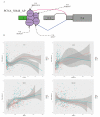TF-RBP-AS Triplet Analysis Reveals the Mechanisms of Aberrant Alternative Splicing Events in Kidney Cancer: Implications for Their Possible Clinical Use as Prognostic and Therapeutic Biomarkers
- PMID: 34445498
- PMCID: PMC8395830
- DOI: 10.3390/ijms22168789
TF-RBP-AS Triplet Analysis Reveals the Mechanisms of Aberrant Alternative Splicing Events in Kidney Cancer: Implications for Their Possible Clinical Use as Prognostic and Therapeutic Biomarkers
Abstract
Aberrant alternative splicing (AS) is increasingly linked to cancer; however, how AS contributes to cancer development still remains largely unknown. AS events (ASEs) are largely regulated by RNA-binding proteins (RBPs) whose ability can be modulated by a variety of genetic and epigenetic mechanisms. In this study, we used a computational framework to investigate the roles of transcription factors (TFs) on regulating RBP-AS interactions. A total of 6519 TF-RBP-AS triplets were identified, including 290 TFs, 175 RBPs, and 16 ASEs from TCGA-KIRC RNA sequencing data. TF function categories were defined according to correlation changes between RBP expression and their targeted ASEs. The results suggested that most TFs affected multiple targets, and six different classes of TF-mediated transcriptional dysregulations were identified. Then, regulatory networks were constructed for TF-RBP-AS triplets. Further pathway-enrichment analysis showed that these TFs and RBPs involved in triplets were enriched in a variety of pathways that were associated with cancer development and progression. Survival analysis showed that some triplets were highly associated with survival rates. These findings demonstrated that the integration of TFs into alternative splicing regulatory networks can help us in understanding the roles of alternative splicing in cancer.
Keywords: RNA-binding protein; TF–RBP–AS triplets; alternative splicing; regulation mechanism; transcription factor.
Conflict of interest statement
The authors declare no conflict of interest.
Figures






Similar articles
-
Systematic analysis of alternative splicing signature unveils prognostic predictor for kidney renal clear cell carcinoma.J Cell Physiol. 2019 Dec;234(12):22753-22764. doi: 10.1002/jcp.28840. Epub 2019 May 29. J Cell Physiol. 2019. PMID: 31140607 Free PMC article.
-
Modulator-Dependent RBPs Changes Alternative Splicing Outcomes in Kidney Cancer.Front Genet. 2020 Mar 26;11:265. doi: 10.3389/fgene.2020.00265. eCollection 2020. Front Genet. 2020. PMID: 32273884 Free PMC article.
-
Transcriptome-wide analysis reveals the coregulation of RNA-binding proteins and alternative splicing genes in the development of atherosclerosis.Sci Rep. 2023 Jan 31;13(1):1764. doi: 10.1038/s41598-022-26556-6. Sci Rep. 2023. PMID: 36720950 Free PMC article.
-
RNA-Binding Proteins in Cancer: Old Players and New Actors.Trends Cancer. 2017 Jul;3(7):506-528. doi: 10.1016/j.trecan.2017.05.003. Epub 2017 Jun 20. Trends Cancer. 2017. PMID: 28718405 Review.
-
Emerging roles of RNA and RNA-binding protein network in cancer cells.BMB Rep. 2009 Mar 31;42(3):125-30. doi: 10.5483/bmbrep.2009.42.3.125. BMB Rep. 2009. PMID: 19335997 Review.
Cited by
-
Development and implementation of a prognostic model for clear cell renal cell carcinoma based on heterogeneous TLR4 expression.Heliyon. 2024 Feb 12;10(4):e25571. doi: 10.1016/j.heliyon.2024.e25571. eCollection 2024 Feb 29. Heliyon. 2024. PMID: 38380017 Free PMC article.
-
Nonsense-Mediated Decay Targeted RNA (ntRNA): Proposal of a ntRNA-miRNA-lncRNA Triple Regulatory Network Usable as Biomarker of Prognostic Risk in Patients with Kidney Cancer.Genes (Basel). 2022 Sep 15;13(9):1656. doi: 10.3390/genes13091656. Genes (Basel). 2022. PMID: 36140823 Free PMC article.
-
Differential alternative splicing genes and isoform co-expression networks of Brassica napus under multiple abiotic stresses.Front Plant Sci. 2022 Oct 13;13:1009998. doi: 10.3389/fpls.2022.1009998. eCollection 2022. Front Plant Sci. 2022. PMID: 36311064 Free PMC article.
-
Identification of alternative splicing associated with clinical features: from pan-cancers to genitourinary tumors.Front Oncol. 2023 Sep 25;13:1249932. doi: 10.3389/fonc.2023.1249932. eCollection 2023. Front Oncol. 2023. PMID: 37810965 Free PMC article.
-
Therapeutic effect of iturin A on Candida albicans oral infection and its pathogenic factors.Antimicrob Agents Chemother. 2024 Jan 10;68(1):e0094823. doi: 10.1128/aac.00948-23. Epub 2023 Dec 5. Antimicrob Agents Chemother. 2024. PMID: 38051047 Free PMC article.
References
MeSH terms
Substances
Grants and funding
LinkOut - more resources
Full Text Sources
Medical
Research Materials
Miscellaneous

